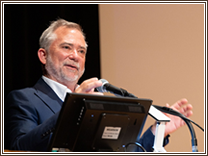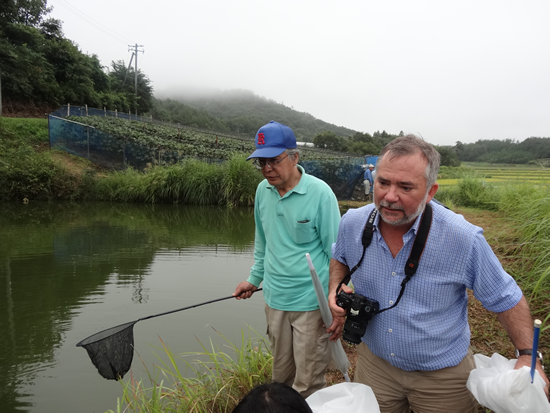ラリー・ヤング博士を偲んで |
(English follows Japanese) |
Emory大学のLarry Young博士が、2024年3月21日に56歳という若さでお亡くなりになりました。
昨年度の日本神経科学学会では、我々はYoung博士を基調講演者としてお招きし、日本の神経科学者との新たな交流が始まったばかりでした。Young博士のさらなるご活躍を心待ちにしていた矢先の訃報に、言葉を失うばかりです。心よりご冥福をお祈り申し上げます。

東北大学大学院 生命科学研究科
脳生命統御科学専攻 分子行動分野教授
竹内秀明
脳生命統御科学専攻 分子行動分野教授
竹内秀明
Emory大学のLarry Young博士が、2024年3月21日に56歳という若さで日本滞在中にお亡くなりになりました。Young博士は翌週3月25日からつくばで開催されたSociety for Social Neuroscienceに一緒に参加する予定でしたが、研究会の初日に訃報を聞きました。Young博士とは2013年に国際会議でお会いしてからの付き合いで、コロナの時期以外はほぼ毎年学会に参加した後、一緒に国内外で旅行をしました。特に2015年には岡山県で野生メダカの採集にいったことを思い出します。
Young博士は社会神経科学の真のパイオニアであり、リーダーであり、研究者だけでなく人間としても類まれな方でした。私を含め多くの人が彼に励まされ、勇気を持って自分が信じる研究を進めることができたと感じています。Young博士は、若い頃から比較生物学的なアプローチをとっており、1996年にテキサス大学オースティン校で、単為生殖トカゲ(C. uniparens)の擬似性行動をテーマに博士号を取得しました。C. uniparens は雌のみで構成され単為生殖によって繁殖しますが、Young博士 は雄と雌の両方の性行動に典型的な行動(擬似性行動)を示すことを報告しました。このように学生時代から動物のユニークな性行動に着目し、動物の特性を見抜くことでオリジナルの研究分野を切り開いてきました。1996年にエモリー大学に着任して以降、一夫一婦のプレーリーハタネズミに関する画期的な研究を始めました。プレーリーハタネズミは米国中西部に生息する齧歯類です。原野ではつがいで罠にかかることから、夫婦の絆が非常に強いと考えられたため、Young博士は研究材料として選んだと言っていました。それ以来、Young博士はつがいの絆を制御する仕組みを理解することに専念し、特にオキシトシンやバソプレッシンがつがいの絆を形成し維持する上で果たす役割を解明し、比較(進化)生物学と神経科学が融合した新分野を切り拓きました。近年ではオキシトシンは魚類からヒトにいたるまで社会認知や社会的意思決定に関与することが示され、基礎生物学分野だけでなく精神医学研究をはじめとする様々な分野に大きな影響を与えました。現在、Young博士は200以上の査読付き原著論文とレビューを発表しており、その中にはScience誌やNature誌などのハイインパクトジャーナルも含まれています。研究論文の被引用回数は世界中で45,000回以上にのぼります。日本語訳もされた彼の著書「The Chemistry Between Us: Love, Sex, and the Science of Attraction」は、脳の化学物質が私たちの対人関係のあらゆる側面にどのように影響するかについての最新の知見を探求しています。
エモリー大学では、Department of Psychiatry and Behavioral Sciences, Emory University School of Medicineの教授であり、Division of Behavioral Neuroscience and Psychiatric Disorders, Yerkes National Primate Research Centerのチーフを務める傍ら、Center for Translational Social NeuroscienceとSilvio O. Conte Center for Oxytocin and Social Cognitionのディレクターを兼任していました。また筑波大学の教授も兼任しており、Center for Social Neural Networksを設立して日本のコミュニティにも大きな影響を持っていました。基礎研究の成果を還元し、精神疾患の治療に向けた新たな戦略も積極的に提案しており、今後のさらなる活躍が期待されていた矢先でした。
彼の突然の死は誰にも予想できるものではなく、私自身、まだ現実を受け止めきれずに深い寂しさの中にいます。しかし、ラリーがいつも私たちの心に温かく寄り添ってくれていたことを思い出し、今はただ感謝の気持ちを込めて彼のご冥福を心よりお祈りしたいと思います。
Young博士は社会神経科学の真のパイオニアであり、リーダーであり、研究者だけでなく人間としても類まれな方でした。私を含め多くの人が彼に励まされ、勇気を持って自分が信じる研究を進めることができたと感じています。Young博士は、若い頃から比較生物学的なアプローチをとっており、1996年にテキサス大学オースティン校で、単為生殖トカゲ(C. uniparens)の擬似性行動をテーマに博士号を取得しました。C. uniparens は雌のみで構成され単為生殖によって繁殖しますが、Young博士 は雄と雌の両方の性行動に典型的な行動(擬似性行動)を示すことを報告しました。このように学生時代から動物のユニークな性行動に着目し、動物の特性を見抜くことでオリジナルの研究分野を切り開いてきました。1996年にエモリー大学に着任して以降、一夫一婦のプレーリーハタネズミに関する画期的な研究を始めました。プレーリーハタネズミは米国中西部に生息する齧歯類です。原野ではつがいで罠にかかることから、夫婦の絆が非常に強いと考えられたため、Young博士は研究材料として選んだと言っていました。それ以来、Young博士はつがいの絆を制御する仕組みを理解することに専念し、特にオキシトシンやバソプレッシンがつがいの絆を形成し維持する上で果たす役割を解明し、比較(進化)生物学と神経科学が融合した新分野を切り拓きました。近年ではオキシトシンは魚類からヒトにいたるまで社会認知や社会的意思決定に関与することが示され、基礎生物学分野だけでなく精神医学研究をはじめとする様々な分野に大きな影響を与えました。現在、Young博士は200以上の査読付き原著論文とレビューを発表しており、その中にはScience誌やNature誌などのハイインパクトジャーナルも含まれています。研究論文の被引用回数は世界中で45,000回以上にのぼります。日本語訳もされた彼の著書「The Chemistry Between Us: Love, Sex, and the Science of Attraction」は、脳の化学物質が私たちの対人関係のあらゆる側面にどのように影響するかについての最新の知見を探求しています。
エモリー大学では、Department of Psychiatry and Behavioral Sciences, Emory University School of Medicineの教授であり、Division of Behavioral Neuroscience and Psychiatric Disorders, Yerkes National Primate Research Centerのチーフを務める傍ら、Center for Translational Social NeuroscienceとSilvio O. Conte Center for Oxytocin and Social Cognitionのディレクターを兼任していました。また筑波大学の教授も兼任しており、Center for Social Neural Networksを設立して日本のコミュニティにも大きな影響を持っていました。基礎研究の成果を還元し、精神疾患の治療に向けた新たな戦略も積極的に提案しており、今後のさらなる活躍が期待されていた矢先でした。
彼の突然の死は誰にも予想できるものではなく、私自身、まだ現実を受け止めきれずに深い寂しさの中にいます。しかし、ラリーがいつも私たちの心に温かく寄り添ってくれていたことを思い出し、今はただ感謝の気持ちを込めて彼のご冥福を心よりお祈りしたいと思います。

写真:岡山県吉備中央町で野生メダカを採集するヤング博士
Photo: Dr. Young collecting wild medaka fish in Okayama Prefecture
Larry Young, PhD (In Memoriam)
Hideaki Takeuchi
Professor, Laboratory of Molecular Ethology,
Graduate School of Life Science, Tohoku University
Professor, Laboratory of Molecular Ethology,
Graduate School of Life Science, Tohoku University
Larry Young, PhD from Emory University passed away on March 22, 2024, at the young age of 56. Dr. Young and I were scheduled to attend the Society for Social Neuroscience meeting together in Tsukuba the following week, starting from March 25, but I learned of his passing on the first day of the conference. I had known Dr. Young since we first met at an international conference in 2013, and we traveled together both in Japan and abroad almost every year after attending conferences, except during the COVID period. I particularly remember when we went to collect wild medaka at Okayama Prefecture in 2015. At last year's Japan Neuroscience Society meeting, we had the opportunity to invite him as a keynote speaker in Sendai, and he had just begun to expand his interactions with Japanese neuroscientists.
Dr. Young was a true pioneer and leader in social neuroscience, and an exceptional person not only as a researcher but also as a human being. Many people, including myself, were encouraged by him and felt that we could courageously pursue the research we believed in. From a young age, Dr. Young took a comparative biological approach, obtaining his Ph.D. from the University of Texas at Austin in 1996 on the topic of pseudosexual behavior in parthenogenetic lizards (C. uniparens). Although this lizard species consists only of females and reproduces through parthenogenesis, Dr. Young reported that they exhibit behaviors typical of both male and female sexual behavior (pseudosexual behavior). From his student days, he focused on the unique sexual behavior of animals and pioneered original research fields by discerning the characteristics of animals. After joining Emory University in 1996, he began groundbreaking research on monogamous prairie voles. Prairie voles are rodents found in the midwestern United States. Because they are often caught in traps as pairs in the wild, they were thought to have very strong pair bonds, and Dr. Young said he chose them as research subjects. Since then, Dr. Young dedicated himself to understanding the mechanisms that control pair bonding, particularly elucidating the role of oxytocin and vasopressin in the formation and maintenance of pair bonds, and pioneered a new field that combines comparative (evolutionary) biology and neuroscience. In recent years, it has been shown that oxytocin is involved in social cognition and social decision-making from fish to humans, having a major impact on various fields, including basic biological sciences and psychiatric research. Currently, Dr. Young has published over 200 peer-reviewed original papers and reviews, including high-impact journals such as Science and Nature. His research papers have been cited over 45,000 times worldwide. His book "The Chemistry Between Us: Love, Sex, and the Science of Attraction," which has been translated into Japanese, explores the latest findings on how brain chemicals influence every aspect of our interpersonal relationships.
At Emory University, he was the William P. Timmie Professor in the Emory University School of Medicine (SOM), Department of Psychiatry and Behavioral Sciences, and served as the Chief of the Division of Behavioral Neuroscience and Psychiatric Disorders at the Yerkes National Primate Research Center, while also serving as the Director of the Center for Translational Social Neuroscience and the Silvio O. Conte Center for Oxytocin and Social Cognition. He also held a joint appointment as a professor at the University of Tsukuba and established the Center for Social Neural Networks, having a significant impact on the Japanese community. He was actively proposing new strategies for the treatment of psychiatric disorders by applying the findings of his basic research, and his further achievements were highly anticipated.
His sudden death was unexpected to everyone, and I myself am still in deep sadness, unable to fully accept the reality. However, remembering how Dr. Young always warmly stayed close to our hearts, I would now like to express my sincerest gratitude and pray for his happiness in the afterlife.






